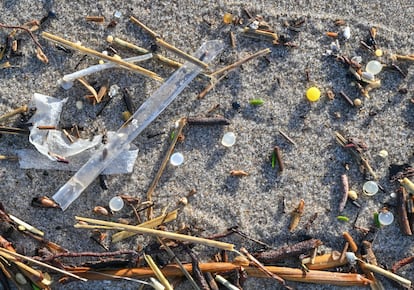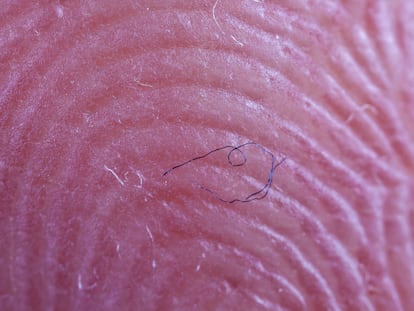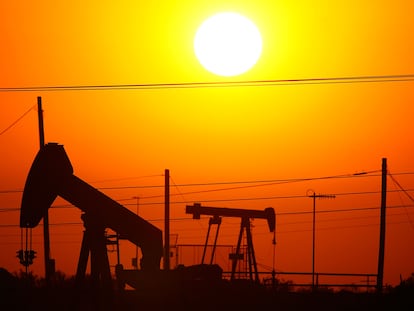Scientists call for global action on microplastics, now found in more than 1,300 species
The amount of plastic entering the environment will double by 2040, according to a scientific review that argues for the need for urgent measures

Barely visible to the eye, microplastics are found in the sea, rivers and lakes, as well as the ice at the poles and in the most distant land on the planet. They are often confused with marine plankton, and enter the food chain. Humans have been eating, drinking and even breathing plastic for decades. Only 20 years ago, a group of scientists introduced the term microplastics for the first time. On Thursday, these same researchers published a new review in the journal Science on what they have discovered since then. Their findings are so alarming they have called for urgent global action to reduce microplastics.
The mass production of plastic did not begin until 1950. A decade later, first fishermen and then scientists warned of the presence of plastic waste in the oceans. By the late 1970s, dozens of studies were warning that smaller pieces of plastic were mixing in with plankton in the North Sea, the Sargasso Sea, the Caribbean, the South Atlantic... But it was not until 2004 — when the journal Science published a short article that mentioned microplastics for the first time — that the word entered into common use. By then, plastic had become essential to human civilization.
Plymouth University professor Richard Thompson was the first author of that Science article that sought to explain the inconsistency between the figures of plastic produced and the amount counted in the sea, realizing that the key was that the pieces of plastic were increasingly smaller. “After 20 years of research, there is clear evidence of harmful effects from microplastic pollution on a global scale,” said Thompson, who has co-authored the latest study in Science. The new work is a review of what science, with more than 7,000 published studies, has learned about microplastic. The first point is that they are everywhere. Microplastics were first detected in the sea, but are also found in the atmosphere. Research into their presence in soil is more recent, but according to this new review, it could even triple the concentration in the seas. Overall, it is expected that, by 2040, the amount will more than double.
“There are still unknowns, but during the 20 years since our first study, the amount of plastic in our oceans has increased by around 50%, only further emphasizing the pressing need for action,” Thompson said in a statement.
What’s more, microplastic and plastic travels long distances. For example, plastic debris generated in Europe and North America ends up in the Arctic Circle, carried by the current, where it breaks down into smaller pieces. Microplastics can even be found in the mountains. In the Pyrenees, for example, the concentration of microplastics is similar to what is found in Paris or in China’s industrial cities.

With a size of a few microns, microplastics are confused with the plankton that many species feed on or are accidentally ingested. According to the new study, microplastics have been documented inside specimens of more than 1,300 species of fish, birds and mammals. From the intestines of anchovies and sardines, through to the stomachs of dolphins and seagulls, and human testicles. While there is no proof yet that this is connected with the fact that the quality of human sperm has dropped by half in the last half century, there is a temporal correlation. Only in recent years have researchers started to understand the impact of microplastic on human health. New research is beginning to document how not only microplastics, but also nanoplastics inside the human body increases the risk of suffering a heart attack or a stroke.
Thompson’s work warns about nanoplastics, which are two or three orders of magnitude smaller than microplastics. As the University of Cadiz researcher Carmen Morales explained; “the smaller they are, the more bioavailable.”
There are two major types of micro and nano plastics: primary and secondary. The former are plastics that were originally micro, such as the fibers that come off a sweater or the tiny pieces of plastic that are released from tires every time we brake too hard. But, according to the British professor’s review, the largest proportion of microplastic is secondary, meaning it comes from the fragmentation of larger pieces of plastic until they become first micro and then nano. The study has found that the rate at which plastic reaches the environment is much faster than the slow process by which its basic components are assimilated by the Earth through mineralization.
The review also takes aim at the illusion of biodegradable plastic. As Morales — who did not participate in this work — points out: “In reality, many of the plastics that are advertised as biodegradable actually break up into smaller pieces.” This, paradoxically, means that the supposedly environmentally friendly products are actually more harmful, as they accelerate plastic decomposition. Since 2019, the European Commission has banned the manufacture and marketing of oxo-biodegradable plastics, which quickly fragment into smaller and smaller pieces in the presence of oxygen but don’t break down at the molecular or polymer level.
Both Thompson and Morales are members of the Scientists’ Coalition for an Effective Plastics Treaty, which lobbies authorities to reduce dependence on plastic. “Most measures place the responsibility on consumers, when the most effective ones should be higher up, at the beginning of the chain,” explained Morales.
In November, the United Nations will perhaps hold the definitive meeting to reach a binding global agreement on microplastics. Morales gives the example of the Montreal Protocol on CFCs, which in 1987 banned the manufacture of CFC gases, as they were causing the hole in the Ozone layer, with a transition phase. “It is not about eliminating plastics to zero, but rather analyzing which are essential and which are not, looking for alternatives,” concludes Morales. Thirty years after the Montreal Protocol, the hole in the ozone layer is beginning to recover.
Sign up for our weekly newsletter to get more English-language news coverage from EL PAÍS USA Edition
Tu suscripción se está usando en otro dispositivo
¿Quieres añadir otro usuario a tu suscripción?
Si continúas leyendo en este dispositivo, no se podrá leer en el otro.
FlechaTu suscripción se está usando en otro dispositivo y solo puedes acceder a EL PAÍS desde un dispositivo a la vez.
Si quieres compartir tu cuenta, cambia tu suscripción a la modalidad Premium, así podrás añadir otro usuario. Cada uno accederá con su propia cuenta de email, lo que os permitirá personalizar vuestra experiencia en EL PAÍS.
¿Tienes una suscripción de empresa? Accede aquí para contratar más cuentas.
En el caso de no saber quién está usando tu cuenta, te recomendamos cambiar tu contraseña aquí.
Si decides continuar compartiendo tu cuenta, este mensaje se mostrará en tu dispositivo y en el de la otra persona que está usando tu cuenta de forma indefinida, afectando a tu experiencia de lectura. Puedes consultar aquí los términos y condiciones de la suscripción digital.
More information
Archived In
Últimas noticias
The complicated life of Francesca Albanese: A rising figure in Italy but barred from every bank by Trump’s sanctions
Pinochet’s victims grapple with José Antonio Kast’s rise in Chile
Reinhard Genzel, Nobel laureate in physics: ‘One-minute videos will never give you the truth’
How Japan is trying to avert ‘digital defeat’
Most viewed
- Pablo Escobar’s hippos: A serious environmental problem, 40 years on
- Reinhard Genzel, Nobel laureate in physics: ‘One-minute videos will never give you the truth’
- Why we lost the habit of sleeping in two segments and how that changed our sense of time
- Charles Dubouloz, mountaineering star, retires at 36 with a farewell tour inspired by Walter Bonatti
- The Florida Keys tourist paradise is besieged by immigration agents: ‘We’ve never seen anything like this’











































